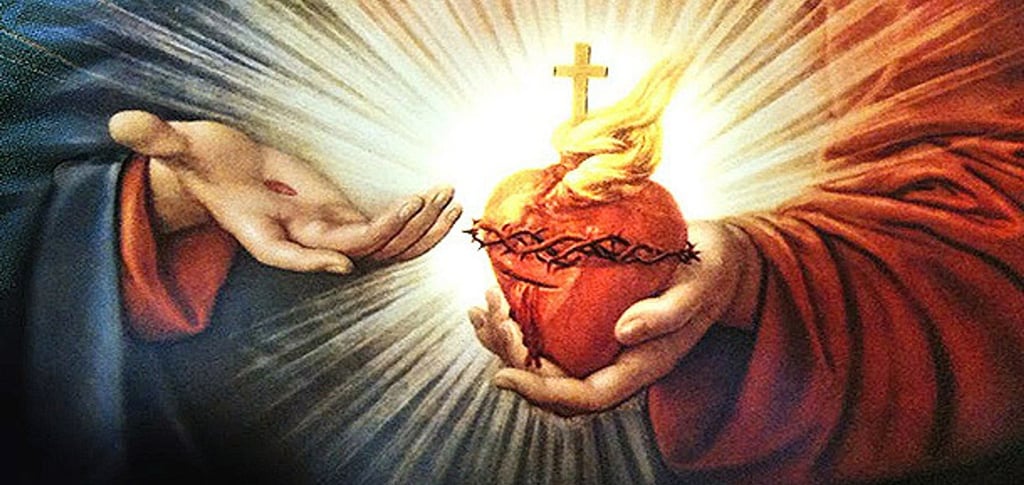Exploring the Devotion of The Sacred Heart Of Jesus
The devotion to the Sacred Heart of Jesus is a rich and multifaceted aspect of Catholic spirituality, encompassing theological depth, historical development, and practical expressions of faith.
HEALING


Exploring the Devotion of The Sacred Heart Of Jesus
The devotion to the Sacred Heart of Jesus is a deeply cherished and significant aspect of my spirituality, encapsulating the profound love and compassion of Christ for humanity. Here I would like to explore some of the theological, historical, and devotional dimensions of the Sacred Heart, highlighting its enduring relevance within the Catholic tradition.
Theological Foundations
The theological underpinnings of the Sacred Heart devotion lie in the understanding of Jesus' love as both human and divine. The Sacred Heart symbolises Jesus' human heart as a representation of His divine love, mercy, and compassion. This symbolism is rooted in scriptural that emphasise Jesus' love and sacrifice. One such passage is John 19:34, which describes the piercing of Jesus' side, from which blood and water flowed—an image often associated with the Sacred Heart.
Theologically, the Sacred Heart represents the unity of Jesus' human and divine natures. In his work "Heart of the Redeemer," Rev. Timothy O'Donnell writes, "The devotion to the Sacred Heart, therefore, brings us face to face with the very heart of the mystery of our redemption: the love of God made manifest in the flesh" (O'Donnell, 1992). This highlights the centrality of the Incarnation in understanding the Sacred Heart, as God's infinite love is made tangible in the human heart of Jesus.
Historical Development
The devotion to the Sacred Heart has evolved over centuries, finding its most significant expression through the revelations received by St. Margaret Mary Alacoque in the 17th century. St. Margaret Mary, a French Visitation nun, reported a series of visions in which Jesus revealed His Sacred Heart to her, expressing His immense love for humanity and His desire for greater devotion to His Heart. These revelations included twelve promises for those who practiced the devotion, such as the promise of peace in families and consolation in times of trouble.
One of the key figures in promoting this devotion was St. Claude La Colombière, St. Margaret Mary's confessor. He played a crucial role in disseminating the message of the Sacred Heart and encouraging the establishment of its Feast. The Feast of the Sacred Heart was eventually approved by Pope Pius IX in 1856 and is celebrated on the Friday following the Solemnity of Corpus Christi. This feast emphasises the connection between the Sacred Heart and the Eucharist, as both represent the boundless love of Christ.
Devotional Practices
Devotion to the Sacred Heart manifests in various forms, including prayers, liturgical celebrations, and acts of consecration and reparation. The Litany of the Sacred Heart, a well-known prayer, highlights different aspects of Christ's love and mercy, invoking His heart as a source of solace and strength. The Act of Consecration to the Sacred Heart is another popular prayer, in which individuals and communities dedicate themselves to Christ's love and seek to live in accordance with His will.
The First Friday devotion is a significant practice associated with the Sacred Heart. It involves receiving Holy Communion on the first Friday of nine consecutive months, in honour of the Sacred Heart, as requested by Jesus in His revelations to St. Margaret Mary. This devotion is often accompanied by the Sacrament of Reconciliation and prayers of reparation for sins, reflecting the theme of making amends for the ways in which human actions have wounded the heart of Jesus.
Enthronement of the Sacred Heart in homes and institutions is another important practice. This involves placing an image or statue of the Sacred Heart in a prominent place and consecrating the space to Christ's love. This practice serves as a reminder of Jesus' presence and a call to live in accordance with His teachings. In his book "The Devotion to the Sacred Heart of Jesus," Fr. John Croiset, S.J., emphasises the significance of this practice: "The installation of the Sacred Heart in homes is a testimony of faith and a powerful means of drawing down His blessings on the household" (Croiset, 1694).
Impact on Catholic Spirituality
The devotion to the Sacred Heart has had a profound impact on Catholic spirituality, shaping the way believers understand and experience the love of Christ. It has inspired countless individuals to seek a deeper relationship with Jesus and to live lives marked by compassion, mercy, and self-giving love
One of the key aspects of the Sacred Heart devotion is its emphasis on reparation for sins. This concept involves recognising the ways in which human actions have wounded the heart of Jesus and seeking to make amends through prayer, sacrifice, and acts of charity. It fosters a spirit of humility and penitence, encouraging believers to turn away from sin and towards a life of holiness. Rev. Thomas Dailey, O.S.F.S., in his article "The Sacred Heart of Jesus: A Devotion That Must Endure," explains, "Through the devotion to the Sacred Heart, we are reminded of the boundless mercy of Christ and are called to respond with love and reparation" (Dailey, 2012).
The Sacred Heart also serves as a powerful symbol of solidarity with the suffering and marginalised. Jesus' heart is depicted as wounded and aflame with love, reflecting His deep compassion for those who are hurting. This aspect of the devotion calls believers to respond with love and care for those in need, embodying the love of Christ in their actions.
The Sacred Heart in Art and Literature
The Sacred Heart has been a prominent theme in Christian art and literature, often depicted with powerful imagery that conveys its spiritual significance. Artistic representations typically show Jesus pointing to His heart, which is often surrounded by thorns, pierced, and emitting rays of light. These elements symbolise the suffering, sacrifice, and radiance of Christ's love.
One of the most famous artistic depictions is the painting by Pompeo Batoni, "The Sacred Heart of Jesus," which captures the tenderness and intensity of Jesus' love. The image has become an iconic representation of the devotion and is widely used in churches and homes.
Literary works have also explored the theme of the Sacred Heart, emphasising its spiritual depth and transformative power. For instance, the writings of St. Thérèse of Lisieux, known as the "Little Flower," are deeply influenced by her devotion to the Sacred Heart. Her "Little Way" of spiritual childhood and trust in God's love is closely connected to her understanding of the Sacred Heart as a source of divine mercy and compassion.
Modern Perspectives and Challenges
In the contemporary world, the devotion to the Sacred Heart faces both opportunities and challenges. On one hand, the message of Christ's boundless love and mercy is highly relevant in a society marked by division, suffering, and a search for meaning. The Sacred Heart offers a profound spiritual response to the modern human condition, inviting individuals to find solace and purpose in the love of Christ.
The devotion also faces challenges related to secularisation and changing cultural attitudes. In some contexts, traditional devotions may be seen as outdated or irrelevant, and the challenge lies in communicating the timeless truths of the Sacred Heart in a way that resonates with contemporary believers.
To address these challenges, it is essential to contextualise the devotion in light of modern experiences and concerns. This involves highlighting the ways in which the Sacred Heart speaks to issues such as social justice, mental health, and personal relationships. By demonstrating the practical and transformative impact of Christ's love, the devotion can continue to inspire and guide individuals in their spiritual journey.
A Final Reflection
The devotion to the Sacred Heart of Jesus is a rich and multifaceted aspect of Catholic spirituality, encompassing theological depth, historical development, and practical expressions of faith. It invites believers to contemplate the immense love and compassion of Christ, to seek reparation for sins, and to embody the love of Jesus in their daily lives. Despite the challenges of modernity, the Sacred Heart remains a powerful symbol of divine love, offering hope, solace, and a call to deeper relationship with God. Through continued prayer, reflection, and action, the devotion to the Sacred Heart can continue to inspire and transform individuals and communities in the 21st century.
Ancient Apostolic Catholic Church
Embracing faith, inclusion, and compassionate service together.
ST THOMAS AQUINAS SEMINARY
© 2025. All rights reserved
QUICK LINKS
